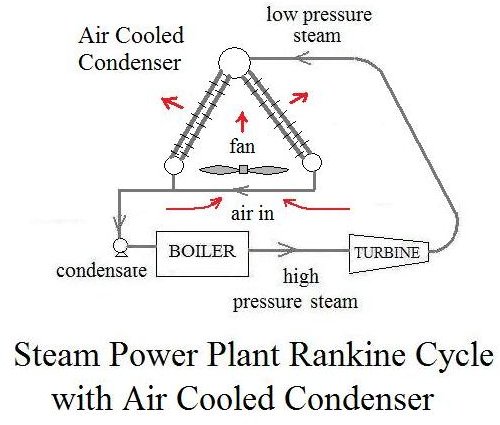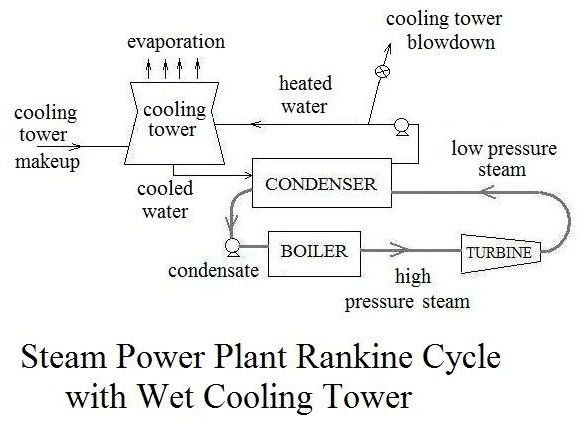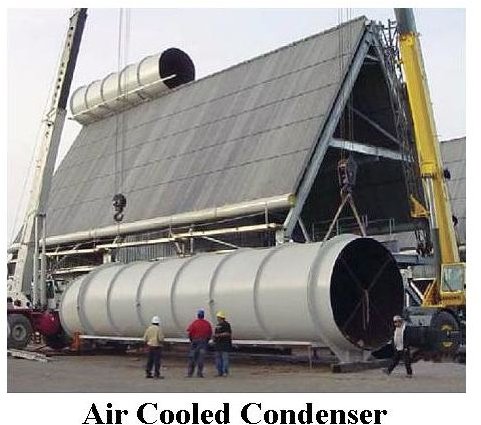Air Cooled Condensers or Dry Cooling Tower: Steam or Steam Power Plant Water Usage
Introduction
An air cooled condenser provides a means of condensing steam without using cooling water, when a lack of water prevents use of a traditional water cooled condenser in a steam power plant. There is increasing interest in use of the air cooled condenser, also called a dry cooling tower, for steam power plant water condensing due to competition from other sectors for use of scarce water resources. The general configuration and options for an air cooled condenser, how it is used for steam power plant water condensing, and an experimental method of improving its performance are discussed in this article.
General Configuration of an Air Cooled Condenser
An air cooled condenser (also known as a dry cooling tower) for use in a steam power plant has two options for air movement: natural draft and mechanical draft. The most common type of air cooled condenser is the mechanical draft, which typically has an overall A-frame configuration as shown

in the picture at the left. The typical flow pattern of steam, air and condensate is shown in the diagram at the right. The low pressure steam exhausted from the turbine goes into the air cooled condenser in the large tube shown at the top of the A-frame in the picture. The steam flows down through finned tubes that make up the A-frame and is cooled and condensed by air being blown past the finned tubes by a fan or fans at the bottom.
A natural draft air cooled condenser requires the familiar hyberbolic tower. The hyperbolic tower must be so large that this option is only used for quite small power plants. A mechanical draft air cooled condenser is used in over 90% of the world power plants with dry cooling.
Use of an Air Cooled Condenser in a Steam Power Plant

The majority of the steam power plants in use today use once through cooling or a wet cooling tower for condenser cooling. Both of these systems require large amounts of water in comparison with a dry cooling tower (air cooled condenser) system, as discussed in the article, Steam Power Plant Condenser

Cooling - Part 2: Comparison of Alternatives. Flow diagrams are shown in this section for comparison with the air cooled condenser diagram in the previous section.
There is increasing pressure to use the dry cooling tower / air cooled condenser option in new power plants because of the concern about and regulation of steam power plant water usage. A plant with an air cooled condenser uses only about 5% as much water as one with once through cooling or a wet cooling tower.
Water Spray Enhancement for an Air Cooled Condenser
While the air cooled condenser has a significant advantage over once through cooling or a cooling tower in terms of water requirements, a steam power plant with a dry cooling tower / air cooled condenser system will typically have reduced plant efficiency and output in the hotter part of the year. A technique being investigated for improving plant efficiency and output in hot weather is inlet spray cooling, that is, spraying water into the air entering the condenser during the hot part of the year, when reduced plant efficiency and output are of concern. A recent study of this procedure is included in the references in the next section. This is one of the ways of combining characteristics of a wet and dry cooling tower, referred to as hybrid wet/dry cooling.
References
Picture of an air cooled condenser: https://www.netl.doe.gov/technologies/coalpower/ewr/water/pp-mgmt/wind-guide.html
GEA Air Cooled Condenser brochure: https://www.geaict.com/opencms/export/sites/default/galleries/gpc_gallery/air_cool_condensers.pdf
Spray Cooling Enhancement of Air-Cooled Condensers, EPRI, Palo Alto, CA, California Energy Commission, Sacramento, CA, and Crockett Cogeneration, Crockett, CA: 2003. 1005360.
About the Author
Dr. Harlan Bengtson is a registered professional engineer with 30 years of university teaching experience in engineering science and civil engineering. He holds a PhD in Chemical Engineering.
Related Reading
1. Steam Power Plant Condenser Cooling - Part 1: Introduction to Alternatives - The steam power plant water going through the condensing unit requires cooling so that liquid condensate can be pumped back into the boiler. Cooling for the condenser may be supplied by once through cooling, a wet cooling tower, dry (air) cooling, a hybrid (wet/dry) system, or a cooling pond.
2. Steam Power Plant Condenser Cooling - Part 2: Comparison of Alternatives - Steam power plant water is used primarily for the condensing unit. The cooling alternatives, once through cooling, wet cooling tower, air cooled condenser, hybrid wet/dry cooling, and cooling ponds each have advantages and disadvantages. Water use, economics and % use in U.S are compared here.
This post is part of the series: Steam Power Plant Condenser Cooling
The main use for steam power plant water is in the condenser. The alternatives for cooling are once through cooling, wet cooling tower, dry cooling tower (air cooled condenser), and cooling pond. Each of the steam power plant cooling methods has advantages and disadvantages.
- Steam Power Plant Condenser Cooling - Part 1: Introduction to Alternatives
- Steam Power Plant Condenser Cooling - Part 2: Comparison of Alternatives
- Steam Power Plant Condenser Cooling - Part 3: The Air Cooled Condenser
- Steam Power Plant Condenser Cooling 4: Hybrid Wet and Dry Cooling
- A Cooling Pond or Constructed Wetlands for Thermal Power Plant Condenser Cooling
